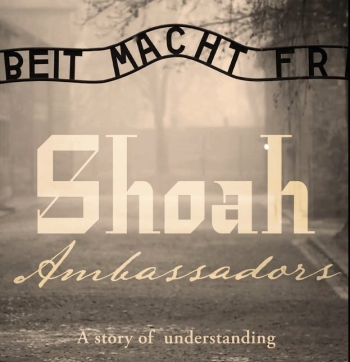
Bearing Witness and Creating Change
After learning about historical events, next steps can take a variety of directions – sharing stories, creating art, leading learning experiences, and advocating for change. Inspired by Michigan-produced and youth-led film Shoah Ambassadors and our U.S. and the Holocaust classroom resources, this “Bearing Witness” student media project invites students to craft video segments that explore historical events and advocate for change. Students may select any history that is interesting and/or significant for them, but we encourage them to look at opportunities to bear witness to stories and examples that are specific to Michigan, including:
- Racial unrest and violence
- Native American removal
- Redlining and post-Civil War segregation
- Violence against immigrants and refugees
- Modern antisemitism and acts of hate/violence
Taking Inspiration
The Shoah Ambassadors Media Activity Deck includes resources for watching, discussing, and engaging with the film – many of the activities within this deck will help students prepare for a larger documentary project like this. You may choose to begin with a viewing of the film, work through some of the “viewing” cards to reflect and debrief, and then choose one or more “producing” cards that students can use to practice media-making and/or produce segments that can be included in the final documentary (i.e. interviews, features, explainers).
3 Steps of Video Creation
Make sure you’ve visited the Getting Started page to familiarize yourself and your students with video and recording practices. This project can be done in small groups, or as a whole class. We recommend having students at least work in small groups so that they can produce a product that they are proud of. If you choose to have them work in groups, help them navigate how they will collaborate (suggested roles: content lead, producer, director, scriptwriter, host). If you choose to work as a whole class, student groups can produce individual segments that combine into a longer documentary.
Research
Students identify their topic of interest and research primary source documents, journal entries, and stories and perspectives from the time period. They should focus on stories that may have been silenced or left out or that can be shared in a new piece of media. Secondary sources can help contextualize the perspectives that they are learning from. If appropriate, students should also conduct respectful interviews with community members who can offer a unique perspective or expert opinion to the work. Help students record their findings and organize the information that they want to include in their final video.
Planning
With research complete, students should work to plan how they want to organize and compose their film. They should identify “segments” for specific events or stories, and organize how they want to share the information – through on-screen graphics, video clips from other sources, clips from recorded interviews, or video of an expert of host speaking directly to the camera. After identifying what segments will be included in the final film, students will need to write scripts and identify visual content to include as their "B-roll."
Production
Finally, students should carefully record, format, and edit their film, combining the various segments that they plan and produce, adding music and graphics, and crafting a final look that is polished and impactful for a viewer.
Showcase Your Work
Once your video or collection of videos is complete, share it with us and we’ll feature it on the Michigan Learning Channel YouTube channel! Just send us an email at MLC@dptv.org.

